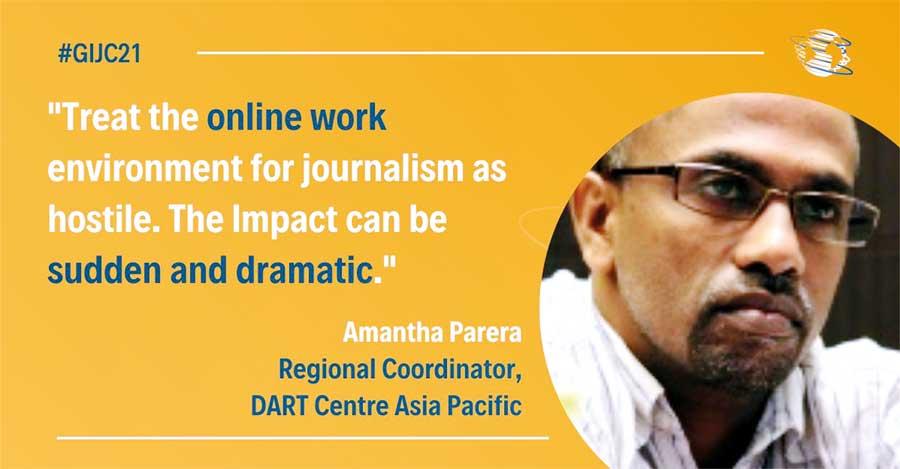17 Nov 2021 - {{hitsCtrl.values.hits}}

- The physical signposts that amplified the heightened dangers of an active combat zone, were even clearer as I began to travel to those zones. Like travelling north. After the north-central town of Madawachchiya, gradually signs of civilian life on the side of the road diminished
- Frontline was a word I heard a lot during the war reporting in Sri Lanka. Back then, there was always unmistakable signs that the frontline was getting closer. Not any more, I could be faced with the digital frontline anytime without any signpost
- There are no clear signposts in the digital frontline, warning of the dangers. There are no skull and bone signs, but the dangers could be equally potent as driving into an active combat zone. We should not make that same mistake twice, of flying blind and scarring ourselves for life
Earlier this month, I was part of a panel at the Global Investigative Journalism Conference on burnout and stress. We spoke in detail about the impact of the last 23 months. As journalism shifted acutely to rely on online and digital tools, online trauma has now become front and centre of the conversation on safety and free expression.
We spoke in detail about the impact of the last 23 months. As journalism shifted acutely to rely on online and digital tools, online trauma has now become front and centre of the conversation on safety and free expression.
One of my co-panellist Rowena Paraan who heads the Philippine’s pioneering citizen journalism platform of ABS-CBN spoke of the digital frontline. This got me thinking.
Frontline was a word I heard a lot during the war reporting in Sri Lanka. Back then, there was always unmistakable signs that the frontline was getting closer. Not any more, I could be faced with the digital frontline anytime without any signpost. I could be travelling in public transport. I could be seated at a workstation or in a park. I could just as well be seated on the throne, flick the screen open and I am in the digital frontline. Gone are the days when the skull and bone in red markings warned me of landmines.
The formative years of my journalism career were spent reporting Sri Lanka’s bloody civil war. I joined The Sunday Leader, quitting a job at the ‘publicity division’ of the Ministry of External Affairs about 18 months after graduating university. I was green as green could get, unprepared and utterly untrained.
I worked in an editorial, especially a news desk which had zero skills on how to cover a bloody war, which then looked unending. There were no physical safety measures. The idea of mental well-being was, in my recollection, never mentioned in that set-up.
Even then though, the war announced when it was near you. I remember one of my first news stories was a suicide attack in front of the Maradana Railway Station, about 2.5km from the then Leader office. There were no vehicles available to get to the blast site. I ran to the location.
Even then, in the sprawling, claustrophobic labyrinth of Colombo’s packed streets, it was unmistakable that you were getting closer to the blast site. Crowds would thin out, military presence would increase, roads would empty of vehicles. Then suddenly, there was a thick layer of peoples across the road. That was the police line, often physically enforced by barriers and armed personnel. About 50 m from the barrier was the blast site, teeming with armed police and security forces personnel. There was no mistaking what this was, it was mini warzone.
The physical signposts that amplified the heightened dangers of an active combat zone, were even clearer as I began to travel to those zones. Like travelling north. After the north-central town of Madawachchiya, gradually signs of civilian life on the side of the road diminished. There were less houses, less shops and the roadside eateries, ubiquitous on regional roads. This stretch of road was mostly straight, and on the two sides it was either parched or caked in dust or lush green, depending on the whether you were travelling before or after the seasonal rains.
The security presence increased as did the stops and document checking. After the town of Vavuniya, the road turned into a dirt track. It would also take sudden, acute turns veering away from security detachments that straddled the road. There was no mistaking that I was heading into an area where the physical dangers were exponentially higher than the road stretched behind me.
Once we were in the active combat zone, those signs were starker from the loud explosions to the physical toll the war took on men, women and children and everything around them.
But we never discussed the impact of all of this on our mental well-being. Not then, never as an occupational safety concern. We thought we could fly blind through this, without any impact on us. How wrong that assumption turned out to be.
There are no clear signposts in the digital frontline, warning of the dangers. There are no skull and bone signs, but the dangers could be equally potent as driving into an active combat zone. We should not make that same mistake twice, of flying blind and scarring ourselves for life.
The writer is a journalism researcher and a writer. He can be contacted on
[email protected]
28 Nov 2024 14 minute ago
28 Nov 2024 34 minute ago
28 Nov 2024 2 hours ago
28 Nov 2024 3 hours ago
28 Nov 2024 3 hours ago